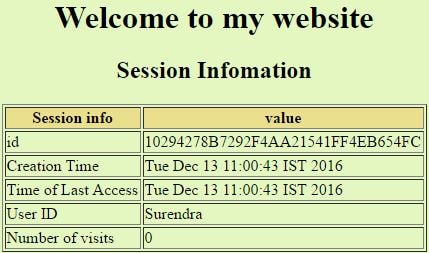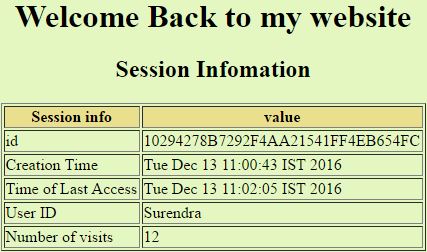import java.io.*;
import javax.servlet.*;
import javax.servlet.http.*;
import java.util.*;
// Extend HttpServlet class
public class SessionDemo extends HttpServlet
{
public void doGet(HttpServletRequest request, HttpServletResponse response) throws ServletException, IOException
{
// Create a session object if it is already not created.
HttpSession session = request.getSession(true);
// Get session creation time.
Date createTime = new Date(session.getCreationTime());
// Get last access time of this web page.
Date lastAccessTime = new Date(session.getLastAccessedTime());
String title = "Welcome Back to my website";
Integer visitCount = new Integer(0);
String visitCountKey = new String("visitCount");
String userIDKey = new String("userID");
String userID = new String("Surendra");
// Check if this is new comer on your web page.
if (session.isNew())
{
title = "Welcome to my website";
session.setAttribute(userIDKey, userID);
}
else
{
visitCount = (Integer)session.getAttribute(visitCountKey);
visitCount = visitCount + 1;
userID = (String)session.getAttribute(userIDKey);
}
session.setAttribute(visitCountKey, visitCount);
// Set response content type
response.setContentType("text/html");
PrintWriter out = response.getWriter();
String docType =
"<!doctype html public \"-//w3c//dtd html 4.0 " +
"transitional//en\">\n";
out.println(docType +
"<html>\n" +
"<head><title>" + title + "</title></head>\n" +
"<body bgcolor=\"#e5f7c0\">\n" +
"<h1 align=\"center\">" + title + "</h1>\n" +
"<h2 align=\"center\">Session Infomation</h2>\n" +
"<table border=\"1\" align=\"center\">\n" +
"<tr bgcolor=\"#eadf8c\">\n" +
"<th>Session info</th><th>value</th></tr>\n" +
"<tr>\n" +
" <td>id</td>\n" +
" <td>" + session.getId() + "</td></tr>\n" +
"<tr>\n" +
" <td>Creation Time</td>\n" +
" <td>" + createTime +
" </td></tr>\n" +
"<tr>\n" +
" <td>Time of Last Access</td>\n" +
" <td>" + lastAccessTime +
" </td></tr>\n" +
"<tr>\n" +
" <td>User ID</td>\n" +
" <td>" + userID +
" </td></tr>\n" +
"<tr>\n" +
" <td>Number of visits</td>\n" +
" <td>" + visitCount + "</td></tr>\n" +
"</table>\n" +
"</body></html>");
}
}
<web-app>
<servlet>
<servlet-name>abc</servlet-name>
<servlet-class>SessionDemo</servlet-class>
</servlet>
<servlet-mapping>
<servlet-name>abc</servlet-name>
<url-pattern>/test</url-pattern>
</servlet-mapping>
</web-app>

